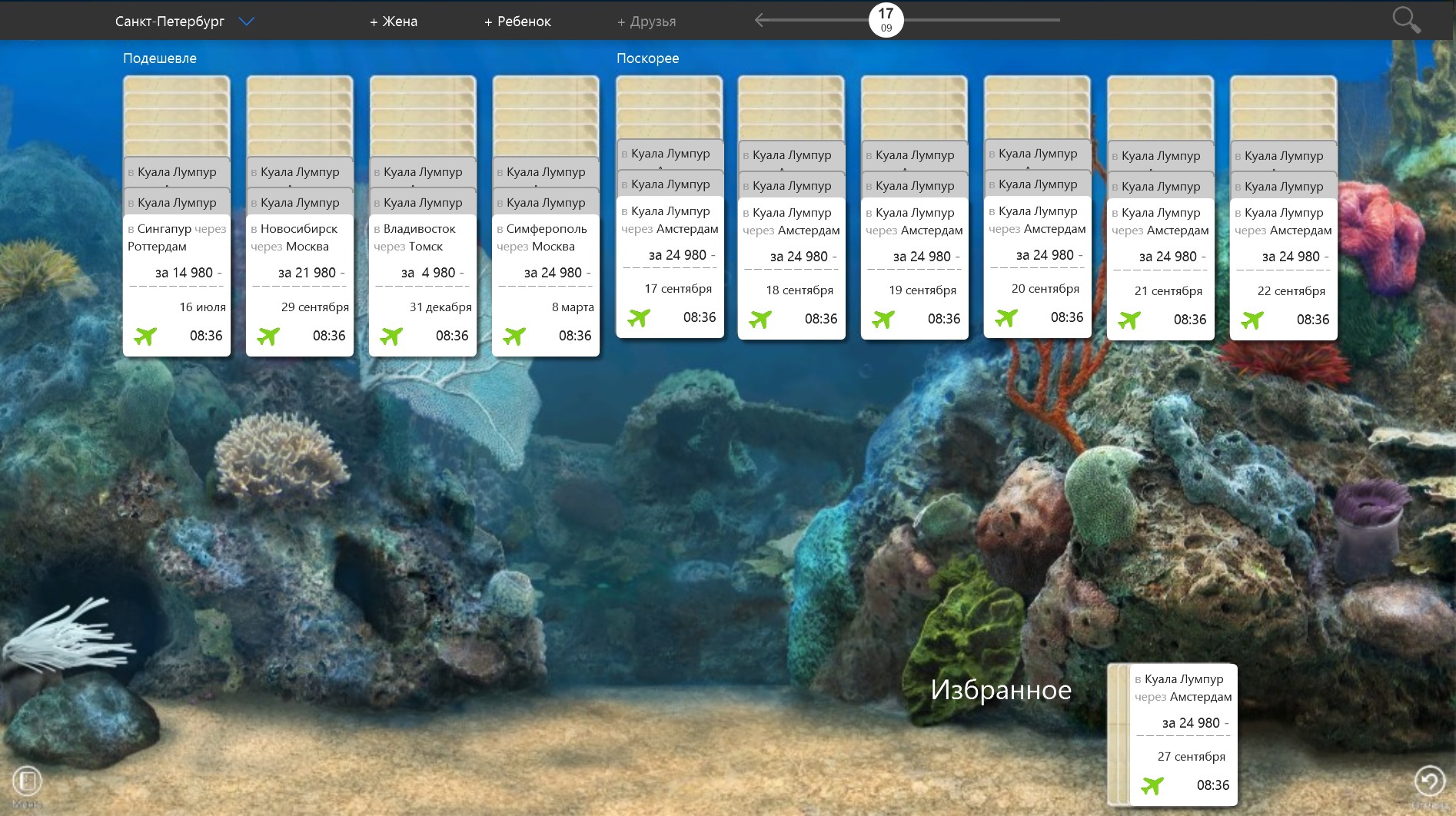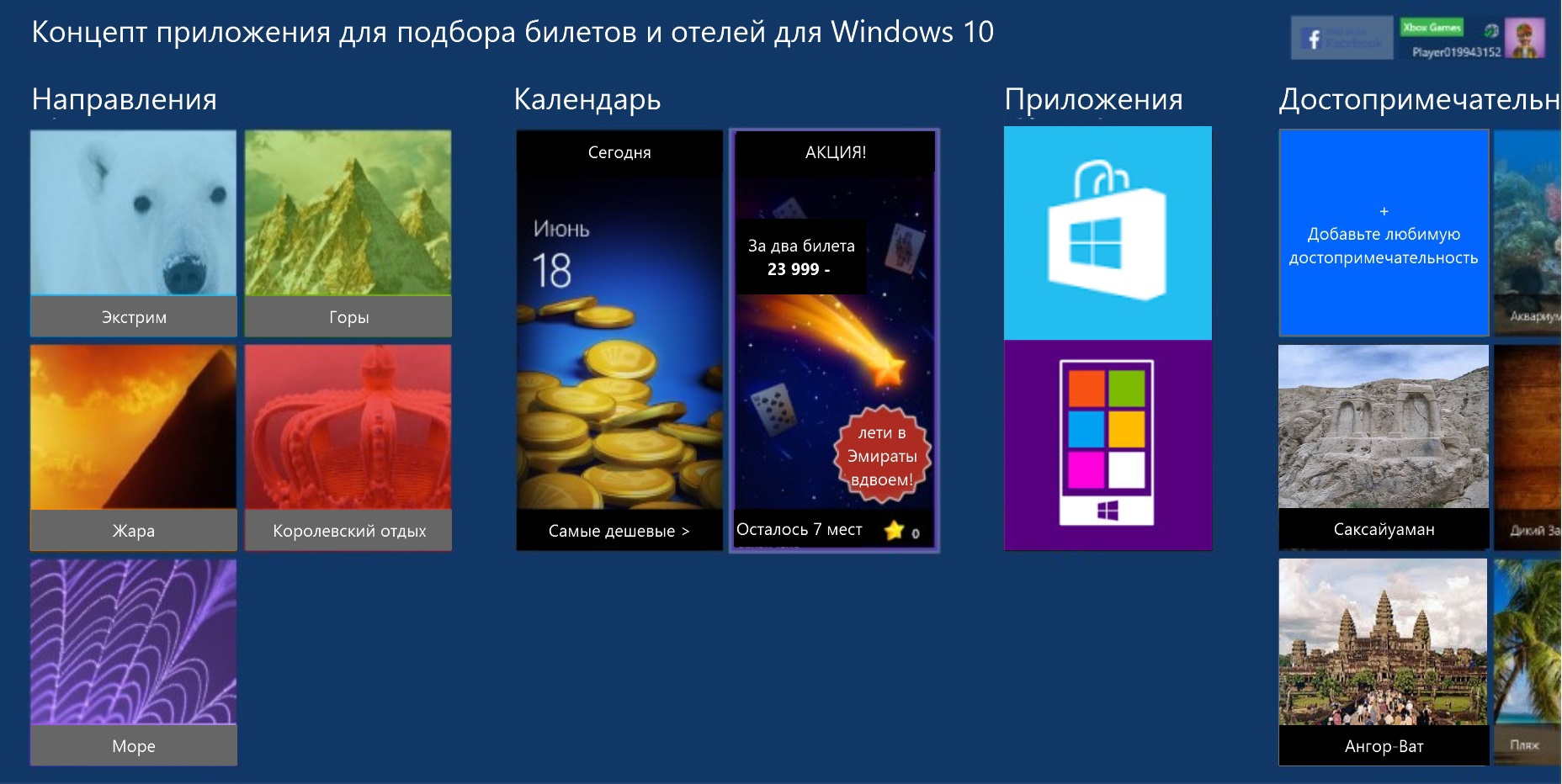Just a little about travel interfaces
In this article, we’ll remember everyone’s favorite solitaire, honestly speak out about the emotions that we experience when searching for keys and a phone in the morning and also prepare a unique interface concept that we have to tear off with our hands in Aviasales.

The idea for this article was thrown to me by a community of Russian-speaking usability experts of the UX Club. This is by far the best team to date for usability and user experience analysis in the industry. Of course, many of you, looking at those projects that exist today in RuNet, will not believe in the existence of any professionals in this industry, but this is normal. The fact is that usability in Russia is still in its infancy and proceeds step by step all the usual childhood diseases:
- lack of understanding that design is a mathematically measurable quantity, and not a picture in the exhibition;
- the evaluation of any prototype is still in vogue in terms of future “by eye” conversion;
- and also everyone's favorite habit of speaking for millions of users in one person.

')
Nothing, over the years it will pass, you just need to grit your teeth to wait another 10-15 years, and random people will subside like foam from this profession, freeing up the space for real experts with a clear understanding of what they do, what for and with what all appreciate it. It takes time until the adolescent adolescents “better than that, because ...”, “are more effective than that, because ...” will replace the evaluation characteristics “good-bad”. So, just yesterday, 5,000 top experts failed to come to a unified conclusion on which five metrics can be used to evaluate the quality of the interface of any travel site. However, despite the absence of measurable indicators, I was still tearfully asked to come up with a “good” interface. Good in the sense that it will be to air tickets to give ice cream and candy, do not force to sleep after 23 hours and not snitching mom ??? Well, let's try. And in view of the absence of generally accepted methods of prototype assessment among design gurus (before combat testing in practice), let us take two things as a basis on which we will be guided when designing: empathy and habitual actions.
Empathy
Does it surprise you that so many information systems in the world rest on the search? Search there, search, here, search everywhere. One gets the impression that a person does not experience much of the same buzz in the world as he does when entering his query in the input field. But is it? Not.
In fact, ordinary people rarely vybeshivaet as much as finding things in real life. Remember yourself: the keys, which yesterday lay on the refrigerator; somewhere a lost, discharged phone; a sock without a pair after washing - yes, you just hate looking for anything. Each of us is so mentally healthy that he believes that all the most important things should be immediately before the eyes, at arm's length. And if they are removed somewhere far away, then clearly into place, in accordance with certain rules of their own and clear personal sorting of things in the house (in the closet or on the desktop).
That is why my first decision: to show the most convenient and obvious suggestions on the site for users on the site looks quite reasonable. It is clear that this is not beneficial for tycoons, magnates and other greedy capitalists, since by showing the best offers at once, they automatically lose all the rest in demand. Well, it would be naive to believe that in domestic design and usability at least something is being done for the end user. Here for the customer, using analytics to find the best out of 400 relatively honest ways of withdrawing money from the population - yes; or to show off in front of competitors - any number; you can still save the budget by hiring the cheapest freelancer - every second person does this. But for the end user with his needs? Alas and oh:

But there are still such cases as the selection of the date (and even a month) of the start of the holidays for the most successful discounts, and choosing the direction “towards the sea”, again, taking into account the time of the flight, the number of transfers - and not out of love for a particular country. How to be with all this? What will help us here is a dull set of fields in the style of a shovel questionnaire “was not, was not involved. Did not consist, the number and signature "? Nothing.
Habit
Probably not in the world of such a user who would not know what an ordinary solitaire is on a computer. So, such an interface, well, if at least one guru of the national UX had the courage to implement such a concept, it would look as familiar as possible, absolutely obvious and would not cause questions. Each user interface in the style of “solitaire” would instantly enter into that very “stream of consciousness”, seeing the usual elements of interaction and, without being distracted by details, would be directed immediately to their final goal. It is also important to note that having successfully achieved the goal of selecting tickets, the conditioned reflex of each person would produce the necessary amount of endorphins, taking from memory the very familiar feeling of a winner, who “successfully played solitaire by the sea”.

Decision
So we come to the conclusion that a card interface should come to our aid, about which there is so much written in the article and slides, but so little is being done. Look at the screen, pliz:

Here, each specific proposal is in the form of a separate card, with which it is easy to interact, sort out, generally remove from the "desktop" or re-sort in their own way. The finished display of several offers can be easily shared with the spouse to agree on a vacation schedule or be used in sending mail to colleagues to clarify the final date of arrival. If the initial screen with the selection of optimal cards did not suit you, you can go to another page and change the selection parameters, but the essence remains the same: the first screen of the application contains ready-made offers, not filters.

How do you like this solution? To a few of my interrogated random acquaintances, it seems ideal. But yes, all this can be both subjectivity and ordinary politeness, so in the comments let us constructively criticize the idea before selling my concept to Costa Kalinov. Especially welcome are the reflections in the style: “I would never try this myself, but I condemn it”, or “by eye there is a conversion of no more than 3.657%”. In general, prove yourself to the full!

The idea for this article was thrown to me by a community of Russian-speaking usability experts of the UX Club. This is by far the best team to date for usability and user experience analysis in the industry. Of course, many of you, looking at those projects that exist today in RuNet, will not believe in the existence of any professionals in this industry, but this is normal. The fact is that usability in Russia is still in its infancy and proceeds step by step all the usual childhood diseases:
- lack of understanding that design is a mathematically measurable quantity, and not a picture in the exhibition;
- the evaluation of any prototype is still in vogue in terms of future “by eye” conversion;
- and also everyone's favorite habit of speaking for millions of users in one person.

')
Nothing, over the years it will pass, you just need to grit your teeth to wait another 10-15 years, and random people will subside like foam from this profession, freeing up the space for real experts with a clear understanding of what they do, what for and with what all appreciate it. It takes time until the adolescent adolescents “better than that, because ...”, “are more effective than that, because ...” will replace the evaluation characteristics “good-bad”. So, just yesterday, 5,000 top experts failed to come to a unified conclusion on which five metrics can be used to evaluate the quality of the interface of any travel site. However, despite the absence of measurable indicators, I was still tearfully asked to come up with a “good” interface. Good in the sense that it will be to air tickets to give ice cream and candy, do not force to sleep after 23 hours and not snitching mom ??? Well, let's try. And in view of the absence of generally accepted methods of prototype assessment among design gurus (before combat testing in practice), let us take two things as a basis on which we will be guided when designing: empathy and habitual actions.
Empathy
Does it surprise you that so many information systems in the world rest on the search? Search there, search, here, search everywhere. One gets the impression that a person does not experience much of the same buzz in the world as he does when entering his query in the input field. But is it? Not.
In fact, ordinary people rarely vybeshivaet as much as finding things in real life. Remember yourself: the keys, which yesterday lay on the refrigerator; somewhere a lost, discharged phone; a sock without a pair after washing - yes, you just hate looking for anything. Each of us is so mentally healthy that he believes that all the most important things should be immediately before the eyes, at arm's length. And if they are removed somewhere far away, then clearly into place, in accordance with certain rules of their own and clear personal sorting of things in the house (in the closet or on the desktop).
That is why my first decision: to show the most convenient and obvious suggestions on the site for users on the site looks quite reasonable. It is clear that this is not beneficial for tycoons, magnates and other greedy capitalists, since by showing the best offers at once, they automatically lose all the rest in demand. Well, it would be naive to believe that in domestic design and usability at least something is being done for the end user. Here for the customer, using analytics to find the best out of 400 relatively honest ways of withdrawing money from the population - yes; or to show off in front of competitors - any number; you can still save the budget by hiring the cheapest freelancer - every second person does this. But for the end user with his needs? Alas and oh:

But there are still such cases as the selection of the date (and even a month) of the start of the holidays for the most successful discounts, and choosing the direction “towards the sea”, again, taking into account the time of the flight, the number of transfers - and not out of love for a particular country. How to be with all this? What will help us here is a dull set of fields in the style of a shovel questionnaire “was not, was not involved. Did not consist, the number and signature "? Nothing.
Habit
Probably not in the world of such a user who would not know what an ordinary solitaire is on a computer. So, such an interface, well, if at least one guru of the national UX had the courage to implement such a concept, it would look as familiar as possible, absolutely obvious and would not cause questions. Each user interface in the style of “solitaire” would instantly enter into that very “stream of consciousness”, seeing the usual elements of interaction and, without being distracted by details, would be directed immediately to their final goal. It is also important to note that having successfully achieved the goal of selecting tickets, the conditioned reflex of each person would produce the necessary amount of endorphins, taking from memory the very familiar feeling of a winner, who “successfully played solitaire by the sea”.

Decision
So we come to the conclusion that a card interface should come to our aid, about which there is so much written in the article and slides, but so little is being done. Look at the screen, pliz:

Here, each specific proposal is in the form of a separate card, with which it is easy to interact, sort out, generally remove from the "desktop" or re-sort in their own way. The finished display of several offers can be easily shared with the spouse to agree on a vacation schedule or be used in sending mail to colleagues to clarify the final date of arrival. If the initial screen with the selection of optimal cards did not suit you, you can go to another page and change the selection parameters, but the essence remains the same: the first screen of the application contains ready-made offers, not filters.

How do you like this solution? To a few of my interrogated random acquaintances, it seems ideal. But yes, all this can be both subjectivity and ordinary politeness, so in the comments let us constructively criticize the idea before selling my concept to Costa Kalinov. Especially welcome are the reflections in the style: “I would never try this myself, but I condemn it”, or “by eye there is a conversion of no more than 3.657%”. In general, prove yourself to the full!
Source: https://habr.com/ru/post/291732/
All Articles